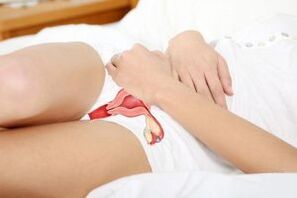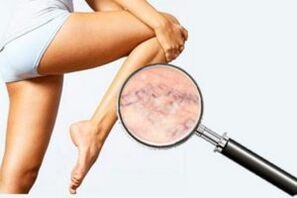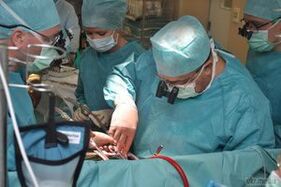The varicose veins of the small pelvis, unlike a similar disorder in the lower limbs, are not always evident, but they are very harmful to health. It can lead to deterioration of blood flow in internal organs and impairment of their function.
The difference between varicose veins and healthy veins
The wall of a healthy vessel is always in good condition - this allows it to maintain blood flow.
The walls contract, although not as much as in the arteries. This effect is enhanced by the contractions of the smooth and skeletal muscles.

All veins under the heart, eg. in the limbs, abdomen, small pelvis, chest, they have valves on the walls. They are "pockets" formed by the vascular endothelium.
Arranged in such a way that the blood flowing to the heart passes unhindered. In retrograde motion, it fills the valves and closes the vessel.
Blood always flows from the periphery to the heart even against gravity.
Varicose veins undergo a series of changes in the valvular apparatus. Their wall tone is reduced and its permeability is increased. Thus, conditions are created for blood stagnation.
Some of the fluid flows around, causing healthy vessels to overflow. And also causing tone disturbances already in them.
What is and what is dangerous
Varicose veins can affect peripheral vessels in any area of the body.
The manifestations of pathology on the legs are more evident: this creates a significant cosmetic defect. But the same phenomenon in the organs of the abdomen or small pelvis is asymptomatic for a long time.
More dangerous for the female reproductive organs, less often for the bladder. Varicose lesions of the rectum are manifested by hemorrhoids.
Pelvic varicose veins can have various causes. As a result, the disease leads to a reduction in blood flow in the reproductive system - a deterioration in its function.
A woman may notice a change in the menstrual cycle, pain, the appearance of signs of hormonal disorders. With physical impact, rupture of the vessel and bleeding are possible.
Reasons
Refers to multifactorial, e. g. arises from a confluence of a number of reasons. Among them:
- hereditary predisposition;
- lack of physical activity;
- complications of pregnancy;
- overweight;
- diseases of the urinary system and intestines;
- hard physical work.

The presence of one or more adverse factors does not mean that the pelvic veins are dilated. This indicates a high risk of such a pathology.
Women with children are more likely to suffer from it than men.
The first signs usually appear around age 40 or late in pregnancy. The actual onset of the pathology occurs much earlier.
Degrees
There are three stages in the development of varicose veins:
- Mild - damage to one or more peripheral vessels of the genital organs. Most often asymptomatic, it can be temporary, re-examination is required.
- Middle - expansion of the large veins of the parameter - the outer shell of the uterus, or myometrium - the muscle membrane. It causes menstrual irregularities, deterioration of health.
- Severe degree - varicose lesions and edema of most organs of the female reproductive system. It causes severe violations in the genital area, a high risk of disease and infertility.
Symptoms
Symptoms vary depending on the location and extent of the lesion. In the early stages, it most often proceeds without symptoms.
With the development of the disease, itching appears in the external genital area, heaviness and pain.
These sensations change in intensity according to the phase of the menstrual cycle. They can intensify during bleeding and subside after a few days.
A woman may notice that her period has become more painful and heavy. Sexual intercourse becomes painful, there are problems with conception and carrying a pregnancy. <
Diagnostic methods
There are several ways to identify a disease.
The first and simplest of these is a gynecological exam. It reveals dilated veins in the skin, vaginal wall and cervix. Its data can indirectly indicate the cause: endometriosis, erosion of the cervix.
The most reliable method is gynecological ultrasound. Its advantage is that it allows you to identify the expansion of the parametrium, fallopian tubes and ovaries. The results of this study provide more complete information on the state of the reproductive system.
In controversial cases, an MRI, vaginal smear, blood test for sex hormones and diagnostic curettage are prescribed.
Which specialist to contact for assistance
The treatment is performed by a gynecologist in collaboration with a vascular surgeon. In case of hormonal disturbances, the consultation of an endocrinologist is necessary. Since the disease is multifactorial, other specialists can also participate in its treatment if necessary.
Since the disease is multifactorial, other specialists can also participate in its treatment if necessary.
Methods of treatment
Before starting treatment, it is necessary to undergo a complete examination of the reproductive system. Identify possible pathologies. As a rule, the disease proceeds against the background of other ailments.
For greater efficiency, an integrated approach is used. Several methods of therapy are used at the same time, which makes it more effective.
Medication
Includes taking drugs that increase the tone of the vascular wall - Diosmin.
To reduce the tissue permeability of the vascular wall, appoint:
- Ascorbic acid;
- Nicotinic acid;
- Routine.
They can also be taken during pregnancy and after childbirth, if the first symptoms appeared at that moment.
Also, your doctor may recommend blood thinners - acetylsalicylic acid, vitamin K.
During pregnancy, their use is allowed only after consultation with an obstetrician-gynecologist, if the benefits outweigh the potential harm.
Compression and sclerotherapy
Tights and compression belts are worn to prevent the complications of varicose veins. They create pressure on the vessels of the external genital organs, preventing their overflow.
Due to this, normal or close to normal venous outflow is maintained through the small pelvis. The degree of compression is determined by the doctor. You can also wear such underwear during pregnancy.
Sclerotherapy is a procedure for injecting a special drug into vessels that stimulates a short-term inflammatory response. And then - complete obturation of the damaged vein and its transformation into a constriction. The blood flow in it stops completely.
This procedure can be performed in the 2-3 trimester of pregnancy, if there are no contraindications.
Operation
Surgical treatment is the removal of the affected area. It can be performed in different ways, depending on the patient's condition.

In some cases, it is necessary to perform a partial resection of the ovary. And sometimes complete removal of the uterus / fallopian tubes.
In women of childbearing age, doctors try to preserve the reproductive organs.
Physiotherapy exercises
These are exercises that help improve blood flow and reduce venous congestion. More effective:
- "birch";
- the back bends in the knee-elbow position;
- Exercises to raise the legs and sacrum area.
They promote blood flow by gravity.
Folk remedies
Traditional treatments are less effective than hospital therapy, however, they can significantly improve the patient's well-being.
For this, baths with medicinal plants are used: willow, oak branches, dry grass and chamomile grass.
They have a calming effect, reduce tension and stimulate blood flow.
Prevention Tips
It is impossible to completely eliminate all factors affecting venous outflow. But you can reduce their impact. For example, set aside time for exercise, keeping your weight within normal limits.
Of particular importance is the prevention of diseases during pregnancy. During this period, it is imperative to monitor both nutrition and physical activity. And also for a sufficient amount of vitamins.
Varicose veins of the small pelvis in women: symptoms and causes, diagnosis and treatment
Pelvic varicose veins are more common in women of reproductive age.
The disease can easily be confused with a number of gynecological diseases, therefore, correct diagnosis and appropriate treatment are required.
Today varicose veins are sick much more often than decades ago. This is due to a sedentary lifestyle.
The disease itself involves a decrease in the elasticity of the venous wall. It can be called differently: varicose veins of the small pelvis, varicocele, chronic pelvic pain syndrome. More often women of childbearing age suffer from the disease.
Occurrence factors
The most common causes of varicose veins in womenare pregnancy and changes in the body's hormonal ratio.
The following factors also bring it:
- use of hormonal drugs;
- constant use of interruption of intercourse for contraception;
- sexual dysfunctions: pain during intimate contact and lack of orgasm;
- numerous and complex births;
- sedentary and sedentary lifestyle or excessive physical activity;
- congenital diseases of connective tissue, weakness of the valves of the veins and the walls of blood vessels.
The risk of varicocele is higher in women with high concentrations of the hormone estrogen.
Information on the symptoms and treatment of varicose veins of the pelvic organs in women in this video:
Symptoms
When the disease begins in adolescence, pathological symptoms are often absent altogether.
The girl may feel completely normal. And changes in the small pelvis are detected by chance with detailed research methods.
In adolescents with varicocele, the only symptom will be severe vaginal mucosal discharge, which can lead to treatment of colpitis.
The most characteristic symptom of varicose veins appears after a woman reaches reproductive age. This is a pain syndrome that affects more than 95% of patients.
It can bother a woman periodically or all the time, but it is observed throughout life and becomes pronounced with menopause.
Pain increases after ovulation, in the second phase of the cycle.
Appears in the lower abdomen, is sore or sharp, can give to the lower back or sacrum.
Varicose veins of the small pelvis can manifest with the following symptoms:
- severe premenstrual syndrome;
- regular vaginal discharge. They are whitish, transparent;
- increased sensitivity of the skin in the perineum and vaginal mucosa;
- menstrual irregularities;
- feeling of pressure and heaviness in the small pelvis, especially if you stay in one position for a long time;
- pain can occur at the end of the day, during sexual intercourse;
- sometimes pathologies of urination appear;
- pain can occur in the final stages of pregnancy;
- there is soreness when exploring the lower abdomen;
- swollen veins may appear on the outer side of the thigh, external genitals, buttocks;
- possible swelling of the vagina and vulva;
- due to the spillage of fluid in the pelvic area, body weight may periodically increase by 2-4 kg;
- possible apathy, weakness, constant fatigue, depression.
What are the causes of varicose veins of the small pelvis
Varicose veins are a common pathology of the circulatory system. Residents of economically developed countries are the most susceptible to the disease. In some regions, one in three suffer from it. In this article you can find useful information on varicose veins of the small pelvis: symptoms, treatment and early manifestations of this form of varicose veins.
What are pelvic varicose veins? Varicose veins in the small pelvis occur due to poor blood flow. The jars are filled with too much liquid. Due to excessive pressure, the walls of the veins become inflamed. The chronic process leads to excessive stretching of the blood vessels.
Although the varicose veins of the small pelvis mainly affect the vessels of the genital organs, the patient should not be observed by a gynecologist or urologist, but by a phlebologist, a specialist in vascular surgery.
With varicose veins of the small pelvis, the photo, on an enlarged scale, clearly shows the excessive elasticity of the vascular walls.
Some people, suffering from a disease such as varicose veins of the small pelvis, the symptoms and manifestations of it can be confused with some diseases of the reproductive system.
Symptoms of the small pelvic veins
Many patients receive inadequate treatment before specialists recognize pelvic varicose veins. Symptoms of the disease are not specific and cannot be used to make an accurate diagnosis:
- Discomfort in and above the pubis, accompanied by painful sensations. The pains are characterized as deaf and drawing, the intensity of the manifestation increases with physical exertion, prolonged sitting and standing, overheating and excessive cooling. Due to the close location of the venous vessels and the spine, patients complain of unpleasant sensations in the lumbar region. Pain is often felt in the perineum.
- Manifestation of varicose veins on the veins of the external genital organs, buttocks and upper legs.
- General weakness.
- Depression, apathy, feelings of depression.
The dilated vessels of the genital organs are unconditional signs of the varicose veins of the small pelvis. The photographs show spider veins and nodular bumps on the patients' skin.
Symptoms in women
There are pelvic varicose vein symptoms that are specific to women.
- The severity of the PMS.
- Dysmenorrhea.
- Soreness of the relationship.
- Mucus discharge from the vagina.
- Swelling in the external genital area.
Symptoms in men
Symptoms in men are different from female manifestations of varicose veins in the small pelvis.
Varicose veins (varicose veins) of the small pelvis in men are in most cases asymptomatic. The only characteristic manifestations of this sex can be: periodic pulling pains and a feeling of heaviness in the scrotum area.
Causes of occurrence
In itself, varicose veins (varicose veins) of the small pelvis, the causes behind the appearance are quite prosaic, ranging from the consequences of weight lifting to bad habits and a sedentary lifestyle. Women of childbearing age are more likely to suffer from this disorder. With the first manifestations of menopause, the risk of developing this pathology decreases dramatically.
Listing the main causes that can cause varicose veins of the small pelvis, there are:
- Disturbance of normal blood circulation in the abdominal organs during pregnancy.
- A sedentary lifestyle in which a lot of time is spent sitting or standing.
- Work related to weight lifting.
- Violation of blood circulation in the vessels of the small pelvis due to interrupted sexual intercourse.
- Use of hormonal contraceptives.
- The negative effect of cigarette smoking on the general condition of blood vessels.
If, after a diagnostic examination, varicose veins of the small pelvis are detected, treatment is likely to include a whole range of measures to alleviate the consequences, reduce pain and at the same time prevent further development of the disease.
Treatment of the pelvic vein
For pelvic varicose veins, treatment consists of taking medications, performing special exercises, using compression products, and following the prescribed diet. Surgical intervention is performed when the methods of conservative therapy are ineffective.
When looking to purchase compression products, keep in mind that wearing them is not easy without proper practice. Don't make your life easier by purchasing a size larger than necessary. The medical vest should support the blood vessels and not just touch the skin!
In any case, before making your choice in favor of this or that compression hosiery product, it is best to first consult with your doctor and know his opinion regarding which model of which manufacturer he recommends in your case. You can also search for information and reviews on the use of compression stockings from various manufacturers on special medical thematic forums.
Drugs
The standard treatment regimen uses:
- diosmin - to eliminate increased elasticity of blood vessels, reduce their permeability, prevent fragility;
- horse chestnut extract (escuzan) - to relieve swelling and inflammation;
- troxerutin - to improve the outflow of blood from damaged vessels, increase venous tone, reduce edema and inflammation;
- vitamin C (ascorutin) - to strengthen the walls of blood vessels.
Do not self-medicate for varicose manifestations! This can lead to serious consequences! If you find the appropriate symptoms, contact a specialist.
Pelvic varicose veins and pregnancy
The greatest risk of this vascular pathology in pregnant women. There are several factors that trigger the disease:
- Increase in the volume of circulating blood.
- Provides a greater load on the vessels of the developing fetus. It compresses the veins and sometimes completely blocks blood circulation in some areas.
- Increased hormone levels. Some of them cause a decrease in vascular tone.
- Rapid weight gain during pregnancy.
Pelvic varicose veins during pregnancy lead to poor blood supply to the fetus. The growing body will feel a lack of oxygen and nutrients. The results of the described violations can manifest themselves as developmental defects of the child.
Varicose veins of the small pelvis often become the culprit of female and male infertility. It can interfere with successful fertilization by preventing the embryo from attaching to the wall of the uterus and disrupting normal placenta formation or reducing sperm production.
Varicose veins of the small pelvis in women: symptoms and causes, diagnosis and treatment
Pelvic varicose veins are more common in women of reproductive age.
The disease can easily be confused with a number of gynecological diseases, therefore, correct diagnosis and appropriate treatment are required.
Today varicose veins are sick much more often than decades ago. This is due to a sedentary lifestyle.
The disease itself involves a decrease in the elasticity of the venous wall. It can be called differently: varicose veins of the small pelvis, varicocele, chronic pelvic pain syndrome. More often women of childbearing age suffer from the disease.
Occurrence factors
The most common causes of varicose veins in womenare pregnancy and changes in the body's hormonal ratio.
The following factors also bring it:
- use of hormonal drugs;
- constant use of interruption of intercourse for contraception;
- sexual dysfunctions: pain during intimate contact and lack of orgasm;
- numerous and complex births;
- sedentary and sedentary lifestyle or excessive physical activity;
- congenital diseases of connective tissue, weakness of the valves of the veins and the walls of blood vessels.
The risk of varicocele is higher in women with high concentrations of the hormone estrogen.
Symptoms
When the disease begins in adolescence, pathological symptoms are often absent altogether.
The girl may feel completely normal. And changes in the small pelvis are detected by chance with detailed research methods.
In adolescents with varicocele, the only symptom will be severe vaginal mucosal discharge, which can lead to treatment of colpitis.
The most characteristic symptom of varicose veins appears after a woman reaches reproductive age. This is a pain syndrome that affects more than 95% of patients.
It can bother a woman periodically or all the time, but it is observed throughout life and becomes pronounced with menopause.
Pain increases after ovulation, in the second phase of the cycle.
Appears in the lower abdomen, is sore or sharp, can give to the lower back or sacrum.
Varicose veins of the small pelvis can manifest with the following symptoms:
- severe premenstrual syndrome;
- regular vaginal discharge. They are whitish, transparent;
- increased sensitivity of the skin in the perineum and vaginal mucosa;
- menstrual irregularities;
- feeling of pressure and heaviness in the small pelvis, especially if you stay in one position for a long time;
- pain can occur at the end of the day, during sexual intercourse;
- sometimes pathologies of urination appear;
- pain can occur in the final stages of pregnancy;
- there is soreness when exploring the lower abdomen;
- swollen veins may appear on the outer side of the thigh, external genitals, buttocks;
- possible swelling of the vagina and vulva;
- due to the spillage of fluid in the pelvic area, body weight may periodically increase by 2-4 kg;
- possible apathy, weakness, constant fatigue, depression.













































